PAINTING: In the first hour, we shall focus on artworks from the postmodern period beginning in 1945, looking especially at those which occupy a middle ground between abstraction and real life. The comparison below is more an introduction to the class than a typical sample of it.



Some questions: Compare these work in terms of their rather similar curving forms, and their quite different palettes and techniques. Are both pictures entirely abstract?
MUSIC: In the second hour, we consider postmodernism in music, as illustrated by video clips
of an opera aria, an avant-garde classic, a rock standard, and an innovative approach to Swan Lake.
PEOPLE: Here are brief bios of the artists we shall consider in the class, listed in order of birth. You can access all biographies via the BIOS link on the syllabus page.
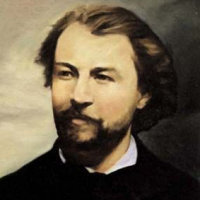 |
Gustave Charpentier, 1860–1956. French composer. A pupil of Jules Massenet, Charpentier found fame with his opera Louise (1900), which combined romance and realism, but this success was not to be repeated. |
 |
Arthur Dove, 1880–1946. American Painter. Dove, who spent some time in France in the ferment of the first decade of the century, is credited with painting the first abstract pictures in America, although he did not exhibit them at the time. |
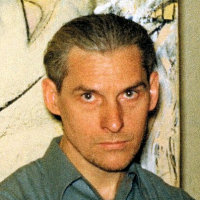 |
Willem de Kooning, 1904–97. Dutch-American painter. Born in Holland, de Kooning came to America as a stowaway in 1926, became an American citizen in 1961. By this time, he was already celebrated as a leading figure in the Abstract Expressionist movement. His paint handling was just about as active as Jackson Pollock's, and his color sense more exuberant, but he never completely abandoned figurative subjects, such as in his series of Women (1953). |
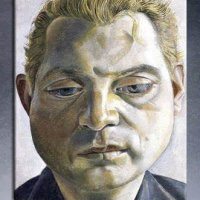 |
Francis Bacon, 1909–92. British painter. Bacon was born in Dublin to English parents, but left home in his teens to move to London and thence to Paris. He had no formal training as a painter, but when he emerged in 1945 with Three Studies for Figures at the Base of a Crucifixion, he both galvanized and divided critics by the fierceness of his imagination and savagery of his style. Alan Bowness, the former director of the Tate, wrote that "no artist in our century has presented the human predicament with such insight and feeling." |
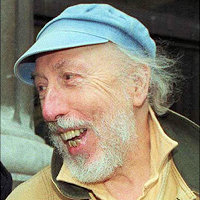 |
Richard Hamilton, 1922–2011. English artist. Discovering his ability as an technical draughtsman, Hamilton turned to art in his twenties, and soon became one of the leading figures in postwar British art. His collage Just what is it that makes today's homes so different, so appealing?, produced for the 1956 exhibition This Is Tomorrow, is considered one of the first creations of Pop Art anyhere. |
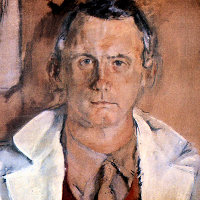 |
Larry Rivers, 1923–2002. American painter and musician. Rivers (born Yitzroch Loiza Grossberg), was a professional jazz soxophonist before taking up painting in his twenties. His earlier paintings were among the first to apply the painterly techniques associated with Abstract Expressionism to narrative and figurative subjects, often as variations on well-known paintings. Quite early on, he began incorporating images from commercial products, earning him the title of "Godfather of Pop Art" |
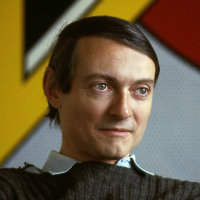 |
Roy Lichtenstein, 1923–97. American painter. Lichtenstein's large-scale blow-ups of images from cartoon romances became one of the defining memes of American Pop Art. He described them as "industrial painting," thus erasing the distinction between fine and commercial art. Later, he began to apply his unmistakable style to reworking classic paintings, such as Van Gogh's Bedroom at Arles. |
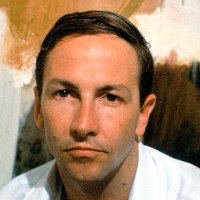 |
Robert Rauschenberg, 1925–2008. American painter. Rauschenberg famously stated that “painting relates to both art and life,” and he wanted to work "in the gap between the two.” He became famous for his Assemblages, paintings in an Abstract Expressionist style which incorporated real objects. He also made extensive use of photographs, screen-printed onto the painting surface. He was the winner of the International Grand Prize in Painting at the Venice Biennale of 1964. |
 |
Helen Frankenthaler, 1928–2011. American painter. A second-generation Abstract Expresionist, she was the first to develop the technique of pouring thin paint onto unprimed canvas, greatly influencing several of her better-known contemporaries. |
 |
Andy Warhol, 1928–87. American multi-media artist. Warhol (born Andrew Warhola Jr.) worked in many media beside painting, including silk-screen print-making, sculpture, and film. Many of his images, such as those of Campbell soup cans, were not only taken from industrial sources, but reproduced multiple times by industrial methods. His studio, which he called The Factory, became the nerve center of American Pop Art. |
 |
Peter Maxwell Davies, 1934–2016. British composer. Sir Peter Maxwell Davies was Master of the Queen's Music (composer laureate) for the last decade of his life, celebrating his by-then establishment status. But he began as a radical, writing works such as Eight Songs for a Mad King that stretched the boundaries of performance practice. Like Britten, he has always liked working for specific performers and places, including many works for his adopted home of Orkney to the North of Scotland. |
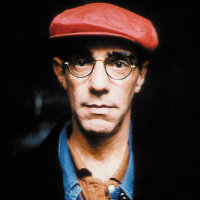 |
Derek Jarman, 1942–94. English film-maker and designer. After training at the Slade School in London, Jarman began his career as a stage designer, including major projects in opera and ballet. His stage collaborations with Ken Russell led to his work in film, which included numerous experimental works, music videos, and a beautiful rendering of Benjamin Britten's War Requiem. A lifelong gay activist, he died of AIDS in 1994. |
 |
Freddie Mercury, 1946–91. English rock musician. Mercury was born Farrokh Bulsara to Parsi-Indian parents in Zanzibar; he came to England when he was 18. In 1970, he formed the band QUEEN with guitarist Brian May and drummer Roger Taylor, fronting the group and writing many of its songs. He was know for his flamboyant style and intense connection with the audience. Mercury died of AIDS in 1991. |
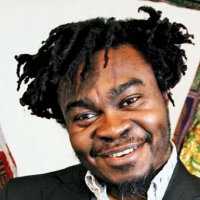 |
Yinka Shonibare, 1962– . Nigerian-British artist. Born in London to Nigerian parents, Shonibare went back to Africa with them as a child, before returning to England in his late teens. He is famous for his use of highly colored African fabrics for his sculptures and assemblages, that frequent explore themes of colonialism and subjugation. Paralyzed on one side of his body through illness, he uses assistants to complete the work that he designs. |
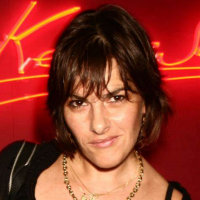 |
Tracey Emin, 1963– . British artist. Notorious for her confessional installations, Everyone I Have Ever Slept With 1963–1995 (a tent appliqued with the names of her many partners) and My Bed (the debris of a depressed week in bed in 1999), Emin is also a Royal Academician and Professor of Drawing at the Royal Academy, |
 |
Cindy Sherman, 1964– . American photographic artist. Sherman's work consists primarily of photographic self-portraits, depicting herself in many different contexts and as various imagined characters. Her series of 70 Untitled Film Stills (1977–80) were black-and-white take-offs of B-movies film noir. Later, she moved into large-format color photographs including detailed props and high-chroma color schemes. |
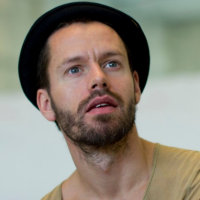 |
Alexander Ekman, 1984– . Swedish choreographer. After five years as a professional dancer in Sweden and Holland, Ekman began a free-lance career as a choreographer when he was 21. His works, which move beyond traditional ballet technique in startling and inventive ways, have been created for or taken up by companies all over Europe. |
ART: The artworks discussed (or intended to be discussed) in the first hour of class
are below. For the music in the second hour, click here.
COMPARISON 1
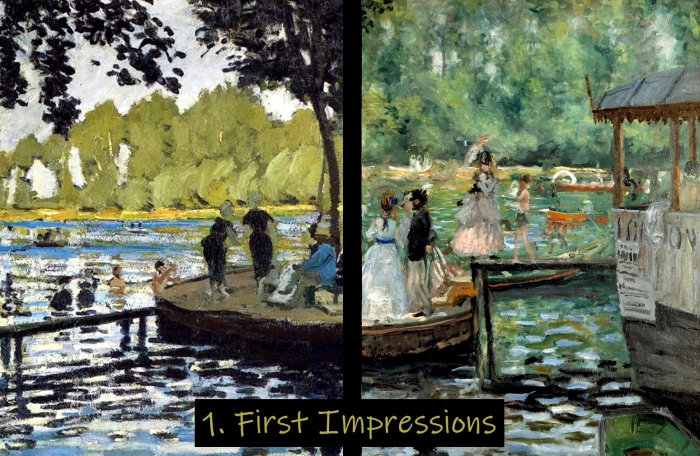


Some questions: Compare these work in terms of their rather similar curving forms, and their quite different palettes and techniques. Are both pictures entirely abstract [they were shown in class without titles]?
Some facts: Dove lived in Paris from 1907 to 1909, absorbing much of the artistic ferment of the time; although painted much later, Goat returns to the color scheme of early Cubism. Frankenthaler invented a method of pouring pigment directly onto the unprimed canvas; this picture combines that technique with more traditional ones; it is one of her many abstract responses to themes from landscape.
COMPARISON 2



Some questions: Compare the mouths in the two pictures; what does each appear to indicate? Do both pictures require their human subjects, or could they stand alone in terms of paint on canvas? How does the artist handle the paint in each case? What feeling do you get from each picture: positive, negative, or deliberately ambiguous.
Some facts: Both Willem de Kooning and Francis Bacon tended to paint in series; there are many other Women and other Popes; see below for more on the latter. This is one of the more abstract of De Kooning's takes on the subject, and closer to Abstract Expressionism; some of the others from the early 1950s, reveal more closely their debt to Picasso.

Eisenstein: Battleship Potemkin (1925) and Velazquez: Portrait of Pope Innocent X (1650)
Some facts: The official title of the Bacon is Study after Velázquez's Portrait of Pope Innocent X; here is the original that he is adapting. Above it is a still from Sergei Eisenstein's 1925 silent film Battleship Potemkin, a screaming nurse who had been wounded in the eye. Bacon called this image a key catalyst in his work.
COMPARISON 3



Some questions: What is the nature of the images quoted in each picture, and the artist's method of doing so? How important is it to know the facts about each? What is the role of the non-quoted elements in each picture? At the time, one picture represented things from the present, the other from a century and a half in the past; how is the perspective changed now that both periods are in the past? What to the titles add to each picture?
Some facts: Rauschenberg used the image of then-Senator Kennedy in several artworks of the time. He ordered it when JFK was still alive, but it reached him a few days after the assassination, confronting him with an icon that had suddenly acquired a quite different meaning. The work sold for almost $89 million in 2019. The Rivers is based on the 1812 painting by Jacques-Louis David, Napoleon in his Study, now in the National Gallery.

Richard Hamilton: Just what is it that makes today's homes so different, so appealing? (1956, Tübigen)
Some questions: What is the role of humor in this work, from the title down to the individual details? It shows Americanized culture, but might it have been different if produced by an actual American? What elements seem out of place in scale or perspective? How is it that a graphic design for a catalogue cover could have been taken as a work of art in its own right?
Some facts: The body builder is Irvin "Zabo" Koszewski, winner of Mr L.A. in 1954; this and much other information comes from the Wikipedia article on the piece and its sources.
COMPARISON 4



Some questions: What, if any, is the role of mechanical reproduction in each picture? Conversely, what is the role of the artist? What does each say about sixties culture? About views of women?
Some facts: Drowning Girl samples a page from issue #83 of Secret Hearts, a romance comic book illustrated by Tony Abruzzo and published by DC Comics in 1962. In Abruzzo’s original illustration, the drowning girl’s boyfriend (called Mal, not Brad) appears in the background, clinging to a capsized boat. Lichtenstein wrote: “My work is actually different from comic strips in that every mark is really in a different place, however slight the difference seems to some. The difference is often not great, but it is crucial.” Warhol used this publicity shot of Marilyn Monroe in numerous works of the sixties. He wrote: "The more you look at the same exact thing, the more the meaning goes away, and the better and emptier you feel."
COMPARISON 5



Some questions: Both these works make use of elaborate costumes; how does their function differ in each case? Both involve a time-shift from the contemporary period in which they were created; what is the effect in each case? Both contain deliberate ambiguities; why? What are their implications in terms of gender roles?
Some facts: The slide shows thumbnails of some other Sherman self-portraits, plus one of the more likely inspirations for this one: Holbein's portrait of Sir Thomas More. Self-portraits are normally intended to reveal some inner truth about the artist, but if the entire persona can change so radically from portrait to portrait, something else seems to be going on. Shonibare's mannequins are dressed in the highly colored fabrics sold for the African market; they are inappropriate for dresses of this period, or pistols of an even earlier period. This combination is one of a series in which the artist addresses questions of colonialism and autonomy.

Title slide (Tracey Emin: My Bed, 1998)
MUSIC: All the clips shown in the second hour are available on YouTube, with the exception
of A Swan Lake by Alexander Ekman, for which I can only provide a trailer. Links are below.
Charpentier/Jarman: "Depuis le jour" from ARIA (1987)
Maxwell Davies: Eight Songs for a Mad King, #7
Mercury: Bohemian Rhapsody (Queen)
Ekman: A Swan Lake (trailer)
• Script for the second hour
PEOPLE: Here are brief bios of the artists considered in the class, in order of birth.
You can access all biographies via the BIOS link on the syllabus page.
 |
Gustave Charpentier, 1860–1956. French composer. A pupil of Jules Massenet, Charpentier found fame with his opera Louise (1900), which combined romance and realism, but this success was not to be repeated. |
 |
Arthur Dove, 1880–1946. American Painter. Dove, who spent some time in France in the ferment of the first decade of the century, is credited with painting the first abstract pictures in America, although he did not exhibit them at the time. |
 |
Willem de Kooning, 1904–97. Dutch-American painter. Born in Holland, de Kooning came to America as a stowaway in 1926, became an American citizen in 1961. By this time, he was already celebrated as a leading figure in the Abstract Expressionist movement. His paint handling was just about as active as Jackson Pollock's, and his color sense more exuberant, but he never completely abandoned figurative subjects, such as in his series of Women (1953). |
 |
Francis Bacon, 1909–92. British painter. Bacon was born in Dublin to English parents, but left home in his teens to move to London and thence to Paris. He had no formal training as a painter, but when he emerged in 1945 with Three Studies for Figures at the Base of a Crucifixion, he both galvanized and divided critics by the fierceness of his imagination and savagery of his style. Alan Bowness, the former director of the Tate, wrote that "no artist in our century has presented the human predicament with such insight and feeling." |
 |
Richard Hamilton, 1922–2011. English artist. Discovering his ability as an technical draughtsman, Hamilton turned to art in his twenties, and soon became one of the leading figures in postwar British art. His collage Just what is it that makes today's homes so different, so appealing?, produced for the 1956 exhibition This Is Tomorrow, is considered one of the first creations of Pop Art anyhere. |
 |
Larry Rivers, 1923–2002. American painter and musician. Rivers (born Yitzroch Loiza Grossberg), was a professional jazz soxophonist before taking up painting in his twenties. His earlier paintings were among the first to apply the painterly techniques associated with Abstract Expressionism to narrative and figurative subjects, often as variations on well-known paintings. Quite early on, he began incorporating images from commercial products, earning him the title of "Godfather of Pop Art" |
 |
Roy Lichtenstein, 1923–97. American painter. Lichtenstein's large-scale blow-ups of images from cartoon romances became one of the defining memes of American Pop Art. He described them as "industrial painting," thus erasing the distinction between fine and commercial art. Later, he began to apply his unmistakable style to reworking classic paintings, such as Van Gogh's Bedroom at Arles. |
 |
Robert Rauschenberg, 1925–2008. American painter. Rauschenberg famously stated that “painting relates to both art and life,” and he wanted to work "in the gap between the two.” He became famous for his Assemblages, paintings in an Abstract Expressionist style which incorporated real objects. He also made extensive use of photographs, screen-printed onto the painting surface. He was the winner of the International Grand Prize in Painting at the Venice Biennale of 1964. |
 |
Helen Frankenthaler, 1928–2011. American painter. A second-generation Abstract Expresionist, she was the first to develop the technique of pouring thin paint onto unprimed canvas, greatly influencing several of her better-known contemporaries. |
 |
Andy Warhol, 1928–87. American multi-media artist. Warhol (born Andrew Warhola Jr.) worked in many media beside painting, including silk-screen print-making, sculpture, and film. Many of his images, such as those of Campbell soup cans, were not only taken from industrial sources, but reproduced multiple times by industrial methods. His studio, which he called The Factory, became the nerve center of American Pop Art. |
 |
Peter Maxwell Davies, 1934–2016. British composer. Sir Peter Maxwell Davies was Master of the Queen's Music (composer laureate) for the last decade of his life, celebrating his by-then establishment status. But he began as a radical, writing works such as Eight Songs for a Mad King that stretched the boundaries of performance practice. Like Britten, he has always liked working for specific performers and places, including many works for his adopted home of Orkney to the North of Scotland. |
 |
Derek Jarman, 1942–94. English film-maker and designer. After training at the Slade School in London, Jarman began his career as a stage designer, including major projects in opera and ballet. His stage collaborations with Ken Russell led to his work in film, which included numerous experimental works, music videos, and a beautiful rendering of Benjamin Britten's War Requiem. A lifelong gay activist, he died of AIDS in 1994. |
 |
Freddie Mercury, 1946–91. English rock musician. Mercury was born Farrokh Bulsara to Parsi-Indian parents in Zanzibar; he came to England when he was 18. In 1970, he formed the band QUEEN with guitarist Brian May and drummer Roger Taylor, fronting the group and writing many of its songs. He was know for his flamboyant style and intense connection with the audience. Mercury died of AIDS in 1991. |
 |
Yinka Shonibare, 1962– . Nigerian-British artist. Born in London to Nigerian parents, Shonibare went back to Africa with them as a child, before returning to England in his late teens. He is famous for his use of highly colored African fabrics for his sculptures and assemblages, that frequent explore themes of colonialism and subjugation. Paralyzed on one side of his body through illness, he uses assistants to complete the work that he designs. |
 |
Tracey Emin, 1963– . British artist. Notorious for her confessional installations, Everyone I Have Ever Slept With 1963–1995 (a tent appliqued with the names of her many partners) and My Bed (the debris of a depressed week in bed in 1999), Emin is also a Royal Academician and Professor of Drawing at the Royal Academy, |
 |
Cindy Sherman, 1964– . American photographic artist. Sherman's work consists primarily of photographic self-portraits, depicting herself in many different contexts and as various imagined characters. Her series of 70 Untitled Film Stills (1977–80) were black-and-white take-offs of B-movies film noir. Later, she moved into large-format color photographs including detailed props and high-chroma color schemes. |
 |
Alexander Ekman, 1984– . Swedish choreographer. After five years as a professional dancer in Sweden and Holland, Ekman began a free-lance career as a choreographer when he was 21. His works, which move beyond traditional ballet technique in startling and inventive ways, have been created for or taken up by companies all over Europe. |
